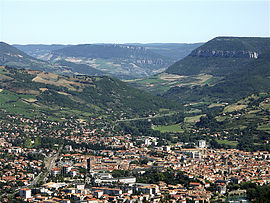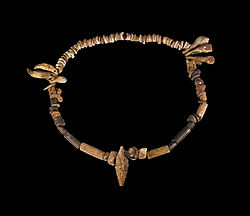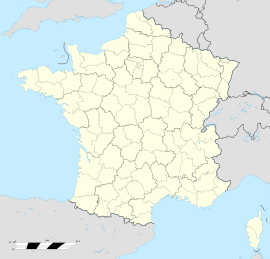- Millau
-
"Milhau" redirects here. For the wine grape also known as Milhau, see Cinsaut.For the cable-stayed road-bridge spanning the valley of the River Tarn near Millau, see Millau Viaduct.
Millau

General view of Millau 
Administration Country France Region Midi-Pyrénées Department Aveyron Arrondissement Millau Canton Millau-Est and Millau-Ouest Mayor Guy Durand
(2008–2014)Statistics Elevation 340–888 m (1,120–2,913 ft)
(avg. 379 m/1,243 ft)Land area1 168.23 km2 (64.95 sq mi) Population2 21,943 (2008) - Density 130 /km2 (340 /sq mi) INSEE/Postal code 12145/ 12100 1 French Land Register data, which excludes lakes, ponds, glaciers > 1 km² (0.386 sq mi or 247 acres) and river estuaries. 2 Population without double counting: residents of multiple communes (e.g., students and military personnel) only counted once. Coordinates: 44°05′55″N 3°04′42″E / 44.0986111111°N 3.07833333333°E
Millau (Occitan: Milhau, primarily spelled Milhaud in French) is a commune in the Aveyron department in southern France. It is located at the confluence of the Tarn and Dourbie rivers.
Contents
History
By the 1st century AD there was a settlement on the spot, identified by Dieudonne du Rey late in the 19th century as Condatomagus, which was the major earthenware centre in the Roman Empire, La Graufesenque.
This major Roman site supplied most of the best pottery right across the Roman Empire for 150 years. It was not in the centre of the town but sat on the right bank of the River Tarn 800 metres (2,600 ft) away.
Yet even today, with much major new development, the centre of the old Roman and medieval town on the opposite (left) bank of the Tarn remains poorly excavated, and the newly renovated Maison du Peuple, almost on the site of the old Roman forum, saw no archaeology before major mechanical excavation for recent new very deep foundations.
Surprisingly, the local museum sits almost adjacent to this site.
In the Middle Ages the town had one of the major mediaeval bridges across the River Tarn. With 17 spans, if it were still standing it would be a major monument; but one poorly maintained span fell in the 18th century, and so the bridge was mostly demolished.
Just one span remains, with a mill, now an art gallery, as testament to this significant trading route from north to south across pre-Renaissance France.
In 1999, José Bové, a local Larzac anti-globalisation activist demolished the Millau McDonalds as it was being built, in symbolic protest of the spread of fast food, Americanization, and the spread of 'Genetically Modified Organisms/crops' (GMO).
The McDonalds was later rebuilt, and Bové received a Presidential pardon from then French President Jacques Chirac.
In the 21st century, clear of traffic jams, the town is a tourist centre with one of the largest touring campsites in central France, and it is a major centre for sporting activity.
Administration
Millau is a sub-prefecture of the Aveyron department in the Midi-Pyrénées region.
Transportation
The Millau Viaduct, the tallest cable-stayed road bridge in the world, which carries the A75 autoroute across the valley of the River Tarn near Millau, relieves the town of much traffic, especially during the summer months.
 Necklace from the Bronze Age - Dolmens de Peyrolevado, Millau – Muséum de Toulouse
Necklace from the Bronze Age - Dolmens de Peyrolevado, Millau – Muséum de Toulouse
Economy
The town is best known for its sheepskin gloves, for which it led the French fashion industry for two centuries.
Tourism
- The glove museum
- The Jardin botanique des Causses, a botanical garden
- The Place du Maréchal Foch, a square with 12th century arcades, one of which carries the inscription Gara qué faras or Watch what you are doing
- Église Notre-Dame-de-l'Espinasse. This church allegedly once possessed a part of the Crown of Thorns, making it an important pilgrimage centre in the Middle Ages. The church was destroyed in 1582 but rebuilt in the 17th century. The frescoes from 1939 are by Jean Bernard, the stained-glass windows from 1984 by Claude Baillon.
- The Passage du Pozous is a 13th century fortified gateway
- The Belfry, a 12th century square tower topped by an octagonal 17th century tower on the place Emma Calvé
- Millau is the main centre in France for paragliding
- Micropolis; the city of insects, is at nearby Saint-Léons
- The nearby underground caves for Roquefort cheese production
Population
Historical population of Millau 1793 1800 1806 1821 1831 1836 1841 1846 1851 1856 6175 6179 6523 8070 9806 10,450 9014 9556 10,041 10,150 1861 1866 1872 1876 1881 1886 1891 1896 12,636 13,663 15,095 15,695 16,628 16,139 17,429 18,754 1901 1906 1911 1921 1926 1931 1936 1946 18,701 18,482 17,673 15,528 15,936 16,190 16,437 17,678 1954 1962 1968 1975 1982 1990 1999 2008 19,209 21,229 22,595 21,907 21,695 21,788 21,339 21,943 International relations
Millau is twinned with Bridlington in England.
In fiction
Part of Ian McEwan's award-winning novel "Atonement" (2001) centers on Briony Tallis, a nurse in a London hospital in June 1940, to which wounded British and French soldiers evacuated from Dunkirk were brought. In a poignant passage, she is comforting Luc Cornet, a young soldier from Millau who is dying of severe head wounds. In his delirium he talks of the town, of his family and his father's boulangerie where he worked, and mistakes Tallis for his own fiancee.
After he dies, Tallis for a moment imagines the life she might have had if Luc had survived and if she had married him and come to live with him in Millau:
"She imagined the unavailable future - the boulangerie in a narrow shady street swarming with skinny cats, piano music from an upstairs window, her giggling sisters-in-law teasing her about her accent, and Luc Cornet loving her in his eager way. She wanted to cry for him, and for his family in Millau who would be waiting to hear news from him. But she couldn't feel a thing. She was empty."
See also
- List of medieval bridges in France
- Communes of the Aveyron department
References
External links
- Millau city council website (in French)
- Tourist office website
Categories:- Communes of Aveyron
- Subprefectures in France
Wikimedia Foundation. 2010.

